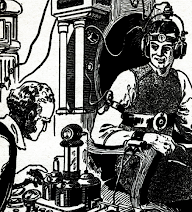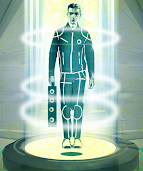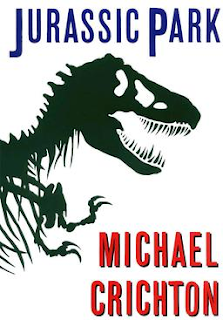 |
| interior art by Ed Emshwiller Mirune and the Savage from "Escape Me Never" |
I'm intrigued by progress in fiction. In the past, early stories depicted fantasy space travel by magic (Somnium, 1608), but nobody living in those pre-industrial times had any idea how it might be possible to actually move people from Earth to the Moon or to other planets.
In the industrial age, new materials were engineered that allowed the construction of powerful chemical rockets. An electronics industry arose that allowed for the creation of rocket control and guidance systems. Eventually, some story tellers adopted the idea of space travel by means of rocketry. A good example of an early rocketry story is "The Satellite of Doom" by Drury D. Sharp (1931), which discusses how to use rockets to put a man-made satellite into Earth orbit. Finally, humans achieved actual space travel by means of chemical rockets and reached the Moon (1969).
 |
| cover art by Frank R. Paul |
Life after death. Another example of progress in fiction concerns "bringing people back from the dead". There is a long history of speculation about how people might die and then be returned to life. Most fantasy reincarnation involves mind-body dualism and the idea that some part of a person is non-material and can continue to exist after a person's physical body dies. Does science fictional teleportation convert people to a non-material form and then return them to life?
 |
| editorial comments for "The Satellite of Doom" |
 |
| interior art by Frank R. Paul |
Brain in a box. Arthur G. Stangland's first published science fiction story was "The Ancient Brain" (1929). "The Ancient Brain" was a strange kind of life-after-death story. William Golend was electrocuted, but his brain lived on for 10,000 years inside a platinum box. Scientists of the future spent centuries studying William's brain.
Brain Transplantation. Finally, surgeons in the year 12,000 placed William's brain into the body of a young chemist who while working with a newly-isolated element had inadvertently turned his own brain into a "gelid gelose". Suddenly, after a 10,000-year-long vacation, William regains consciousness and begins his new life in the future.
 |
| 1950 cover art by Edward Cartier |
Immortal Brains. Published in 1939, "Cosmic Engineers" by Clifford D. Simak depicted Caroline Martin's brain as magically being active and thinking for 1,000 years while the rest of her body was in some kind of suspended animation.
Equations. I've long imagined that a way to get published in old science fiction magazines such as Astounding was to include an equation in your story. Sometimes it is useful to include some equations in a science fiction story if your story is about a technical problem (examples: "The Synpaz of Seelie" and Time Portal).
 |
| interior art for "The Living Equation" |
"The Living Equation" featured a mathematician named Hugh Wilmot who plays the role of the SuperGenius™ inventor working in his attic who invents an invention that can alter the entire structure of the universe.
 |
| Wilmot's theory of a mathematical universe |
"The Living Equation" also reminds me of one of Asimov's most famous stories, "The Last Question" (1956). In 1954 there was another story called "The Last Question" by John Todd. Todd's story is amusing in that he imagined two computers (Big Brain and Little Brain) that could talk to each-other.
 |
| Integraph; interior art for "The Fatal Equation". |
Teleportation? Are stories such as "The Fatal Equation" and John Todd's "The Last Question" actually about teleportation? In both stories, there is a SuperDuper™ computer. In "The Last Question", Big Brain de-materializes and suddenly exits from our universe.
 |
| Teleportation |
In some sense, during teleportation, the transported person is sent into an alternate "reality" where they exist as a kind of mathematical code.
 |
| returned from the teleporter buffer |
A teleportation system with a good memory system could "store" the "pattern" of a person who would then, perhaps much later, be re-materialized and come out of "suspended animation". This was used as a plot element in Star Trek.
Giants From Eternity. An alien life-form falls to Earth and begins to relentlessly kill and consume everything around it. Who can stop the red blight? All of Kansas is consumed by the alien blight! Yawn. The only reason I mention this very pulpish story is because defeating the alien invader only becomes possible when several great scientists from the past are brought back to life.
 |
| interior art for "Giants from Eternity" |
Pink Gas of Life. The crack research team team of Bridge, DuPogue and Norfleet quickly discovers that people can also be brought back from the dead. Readers are told that living organisms have a "life pattern" that can be reconstituted by the mysterious alien "meteor". All you need is a small part of the dead person and a supply of assorted atoms as raw material and "the pink gas of life" can then cause a whole new person to be constructed, complete with all of their former memories!
 |
| from "Giants From Eternity" |
For "Giants From Eternity", DuPogue gets absorbed into the alien life-form and is soon working to convert all of Earth to the alien way of life. Fighting valiantly against Dupogue and the blight are Bridge, Norfleet and a team of resurrected scientists that includes Louis Pasteur, Isaac Newton, Thomas Edison, Marie Curie and Charles Darwin. I have to wonder to what extent Philip Farmer might have been influenced by "Giants From Eternity".
 |
| the dead scientists club |
Escape. For "Escape Me Never", an ancient human from the 20th century (called "the Savage") is resurrected from "a few dead fragments" using the advanced science that is available to the homo superior of our far future. However, after that success, the scientists of the future decide not to resurrect a female from the past.
 |
| bone memory |
 |
| interior art by Ed Emshwiller |
Sadly, James MacGregor was not really interested in trying to provide a fantasy science explanation for how to bring back to life a human from ancient times. Here in 2022, we can imagine that maybe some cells were stored in liquid nitrogen for thousands of years and then some sort of advanced cloning technology allowed the Savage to be brought to life.
For "Escape Me Never", it is eventually revealed that efforts are underway to try to fully integrate the Savage into the society of the future. Each time he escapes from the zoo he makes some more progress in adapting to the society of the future. But if something goes wrong, such as the Savage attacking someone, then his memories are erased by the Psychiatric Bureau and he starts over, back at the zoo.
 |
| Jurassic Park |
 |
| resurrected dinosaur |
Eventually, scientifically-trained science fiction story tellers such as John Crichton wrote stories about using advanced genetics technologies to bring extinct animals back to life.
 |
| in the Ekcolir Reality original cover art by Ed Valigursky |
Next: The Prisoner of L2, a new science fiction story about inventing teleportation technology
 |
| An early teleportation story, “The World Without Name” (Wonder Stories, March 1931). |



No comments:
Post a Comment